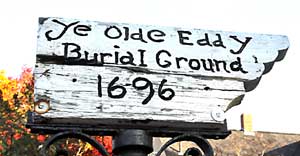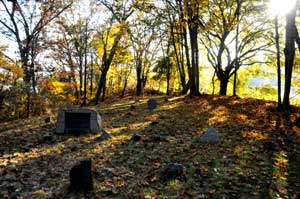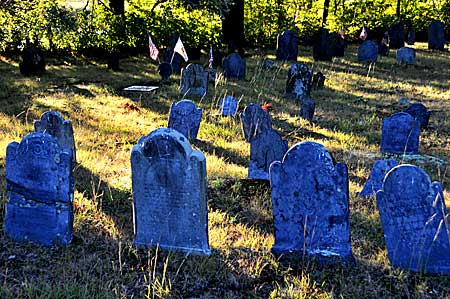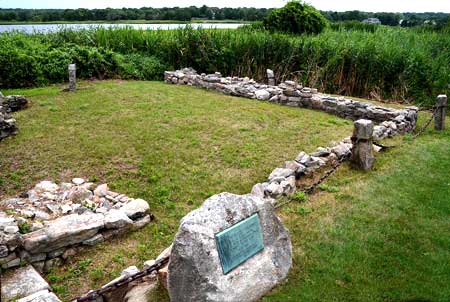![]() King Philip's War & the
Colonial Contact Period in Warren, RI
King Philip's War & the
Colonial Contact Period in Warren, RI
|
The Nathaniel Bosworth (now Perry-Rego) House (left), portions of which were built in 1680, is the oldest existing structure built in Bristol following the King Philip War as Bristol began to be occupied by English settlers for the first time.
The Joseph Reynolds House (left) at 956 Hope Street in Bristol was built following the King Philip War in 1684.
Elm Farm (left) at 1382 Hope Street is another 17th Century house. a portion of which was constructed in 1695, still standing in Bristol. |
| While none of
the structures that existed at the time of the War remain, some evidence
exists today of what those structures must have looked like.
The house at Haile-Nunes farm (below), built by
Levi Haile in 1682
on what is now Market Street in North Warren, is the only remaining 17th
Century structure in Warren.
The Arnold House (right) in Lincoln, R.I. (c.1687) is a rare surviving example of the "stone-ender" a common building type constructed by the English settlers at the time of the King Philip's War. The Benjamin Cole House (right) was constructed on Old Warren Road in nearby Swansea in 1701 for the grandson of James Cole, the son of Hugh Cole, for whom the Coles River is named. The house contains original woodwork throughout the interior and exterior and a central chimney that feeds six fireplaces. According to owner Eileen Pereira, the "Indian Room" was constructed with 2-inch-thick wooden planks going around the entire room to protect the children from arrows. “They built the room because of the many Indian attacks during the King Philip War,” said owner Eileen Pereira of the room that is now a large closet. “They would throw the children into that room to keep them safe.” The original part of the John Martin House 1707 (right), at 123 Massasoit Avenue in Barrington is the oldest surviving structure in that town. The east end was constructed as a two-story house with a brick and stone end chimney like the Arnold house, above. The present structure replaced an earlier house built in the King Philip's War. Captain John Martin enlarged it to its present-day facade in the mid-18th century. |
The Roger Mowry
House, (drawing below,) a 17th Century Rhode Island Stone-ender built in Providence, Rhode
Island circa 1653 and now demolished, exemplifies the type of house that
was likely built in Warren in the 1600s.
Built by Richard Clemence c. 1680, the Clemence-Irons House (below, left) is another example of a
"stone-ender," a once common building type first developed in
the western part of England. (Information about visiting each of these
structures is available at the Society for the Preservation of New England
Antiquities website at www.spnea.org.)
|
 A family burial ground at the end of Ledge Road near
the center of Swansea holds the remains of some of the original English
settlers who survived the King Philip War. Samuel
Eddy came to Plymouth in 1630. Zachariah and Caleb Eddy were among the
55 original purchasers of Swansea from the Indians in 1669.
A family burial ground at the end of Ledge Road near
the center of Swansea holds the remains of some of the original English
settlers who survived the King Philip War. Samuel
Eddy came to Plymouth in 1630. Zachariah and Caleb Eddy were among the
55 original purchasers of Swansea from the Indians in 1669.
More burials of survivors of the King Philip War can be seen at the Kickemuit Cemetery along the northern end of Serpentine Road that borders the Kickemuit River. Graves of Samuel Luther, John Millard, and Richard Haile, among others can be found here..
|
 
|

|
There is evidence of the King Philip War all over
Massachusetts, Rhode Island and Connecticut in the form of historical
markers.
The site pictured to the left is the Russell Garrison in North Dartmouth that was attacked early in the war. The site can be found on Fort Street at the western end of Lucy Street in North Dartmouth. A Google search for "King Philip War" will bring up hundreds of other sites and descriptive articles. |
| In addition to structures, living examples of both the flora and the people who originally occupied Sowams can be seen today. | |
|
To see an example of an
old growth stand of trees from the time of the King Philip War, visit the
Oakland farms woodland in Middletown. This 300-year-old virgin forest off
East Main Road near Union Street, is
thought to be the last vestige of the forests that existed at the time of
King Philip. Included in this stand are American beech, white oak, red
maple and scarlet oak trees. Two or three of
the white oaks are believed
to be perhaps 350 years old. To read more, go to Eastern Old Growth Notes
The English colonists were not the first to visit the area. Some believe that Portuguese explorer Miguel Corte Real left inscriptions on Dighton Rock in 1511. As early as 1504, French, Portuguese and Basque fishermen were exploring the coasts of Newfoundland and Nova Scotia and probably made contact with the native population. In 1524, Verrazzano documented a two-week visit with the Natives in Narragansett Bay. The following year, in 1525, the Portuguese explorer Esteban Gomez not only visited the area but also kidnapped and brought back to Spain a large number of Indians. Jacques Cartier made three voyages to the area for King Francois I of France.
|
| The Council Oak tree still stands in a field behind the Dighton Community Church at 2036 Elm Street in Dighton, MA. Here, King Philip met with tribal members from across the area. It remains a sacred place for Native Americans to the present. The huge tree's trunk is 16' in circumference but significant storm damage during Hurricane Gloria left only one branch intact, and today only the trunk remains. |
|
|
Today, Native American
descendents continue to live in Southeastern New England. Pictured at
the left are Strong Woman (Julie Jennings) and Nikana-Little Friend (Chris
Ortiz) who participated in Heritage Day, on October 28, 2000, at Martin
House (below), built in 1728 in Swansea and maintained by the National
Society of the Colonial Dames of America in the Commonwealth of
Massachusetts.
|